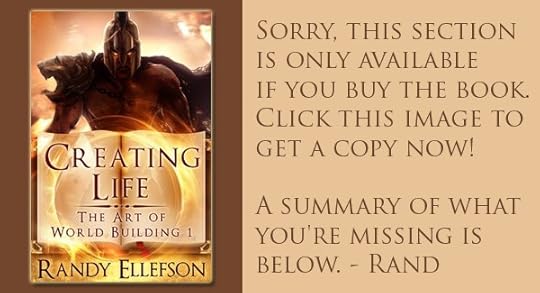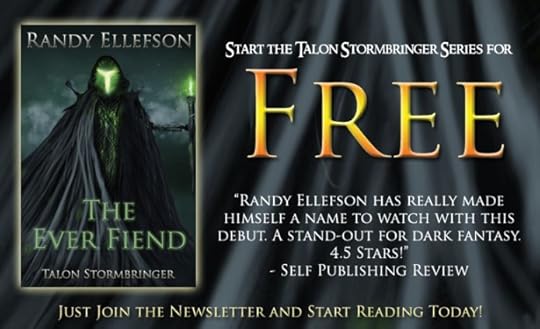Randy Ellefson's Blog, page 32
April 26, 2018
How to Create a Continent
Despite the term “world building,” we usually build far less than that in detail. Fantasy tends to utilize one continent. SF will typically use multiple planets, but on each, a single location (like a city) is used. Chapter Six, “Creating a Settlement,” covers the invention of single cities, so this chapter discusses inventing a continent, even if we’ll only use portions of it in detail. Multiples continents can be created following the advice herein. It’s also possible to create a single, large supercontinent, like Pangaea or Gondwana.
We don’t need to invent every region of our continent, but some basic thought should still be given to areas we won’t utilize as much. It adds depth to our work to say that a product, like wine or furniture, came from a certain region. We can invent that on the fly instead of planning it, but there’s more to life than products. Different sovereign powers will exist and have histories with each other. Allies and enemies flourish. Grievances are to be nurtured. Stereotypes, racism, and ethnic hatreds blossom. We can do all this and more by laying out a continent so we know where these people in conflict live. It’s crucial for any story involving travel, like a quest, which typically involves a journey through hostile places; otherwise, any schlep could go get the quest token.
Multiple Continents
We don’t have to invent more than one continent, but to make our main one seem less like an island, we can name other continents and decide what they’re famous for. We might never use them. But then maybe people on our main continent know of another where people are free, and those in an oppressed kingdom dream of going there. Travelers from faraway lands will eventually reach our shores. Why not have some ideas on where they originated?
Creating multiple continents doesn’t necessarily mean laying out each in detail. Here’s a simple process we can follow to get started for one:
Draw a rough shape on paper
Decide where the land mass lies in relation to the equator and where it is in relation to the others
Give the continent a name
Carve it up into sovereign powers
Add names to those powers
Decide what each power is like, using Chapter 5, “Creating a Sovereign Power.”
That can be it for now, or maybe we’ll go one step further and decide on some reputations for the entire continent or various regions in it. Think about the Earth and what intrigues us about a place, then create such a one somewhere. We might want to save the best ideas for our main continent, but some things will be true of multiple places, like naval powers. There’s usually at least one per continent. We can ask ourselves some questions for inspiration:
Is there a kingdom known as a naval superpower, whose ships and raiders will reach our main continent’s shores?
Is there a slave trade somewhere?
Huge rainforests?
Impenetrable mountains?
Vast deserts?
Exotic animals?
A spice trade? Or trade in something of our invention, like supernatural or technological elements?
Which Hemisphere?
The differences between a planet’s northern and southern hemispheres is largely trivial but has various consequences. What matters most is where our continent lies in relation to the equator. The reasons this is important are laid out in Chapter 2, “Creating a Planet,” but amount to determining climate. We can draw mountain ranges without having decided this, but no desert, grassland, or forest should be placed without this decision. The combination of prevailing winds, which are solely determined by latitude, and mountains will influence the location of vegetation, as discussed Chapter 2 under “Rain Shadows.”
Those who travel between hemispheres will note that any moons look upside down. So will constellations. Moon phases are also reversed, which can matter if we’re planning to do something like supernatural spells that depend upon the moon’s phase. An old game called Ultima IV had moon powered portals that only operated at certain moon phases, but the continent spanned only one hemisphere, presumably.
Seasonal Issues
Those world builders who are used to living in one hemisphere might need to remind themselves, when creating a continent in the other hemisphere, that cold regions are not north/south but poleward. The seasons are also reversed; when it’s winter in the north, it’s summer in the south. This matters more during storytelling, but it also impacts constellations, as noted in the previous chapter. It can impact our calendar if we’re not careful; this is discussed in Chapter 10, “Creating Time and History.”
The post How to Create a Continent appeared first on The Art of World Building.
April 23, 2018
Case Study #3 in World Building
In this case study, we look at the impact of mountain ranges on terrain and sovereign powers. If following along with the maps online, expand the following sovereign powers sections: Erizon, Marula, Pell, and Siara.
The Winds and Rain Shadows
In the map below, the equator lies just to the south (off the edge). This means the prevailing winds are westerly. On the map’s right side is a large, north-to-south running mountain range, the Marula Mountains, which acts as a rain shadow that causes the desert to its left. The Nemon Mountains (also on the map’s right side) have a similar effect, causing another desert on their west, called Pell Pass. The War Peaks to the west would once again drain water from the atmosphere, leaving none to fall on the wider Anamaer Plain, which is wetter due to some moisture from the Sea of Fire to the south, resulting in grasslands instead of desert.
Some of this is open to interpretation. For example, Anamaer Plain could be another desert but two already existed in this region and more variety is good. No one from this planet is going to show up on Earth and announce that, in fact, no moisture from the Sea of Fire is coming north to result in more rain. However, it’s unlikely that a full forest would stand there. If you don’t understand why, this book will change that.
Forests stand to the north of these mountain ranges, as there’s no rain shadow; the Marula Mountains don’t go that far north and therefore don’t block moisture
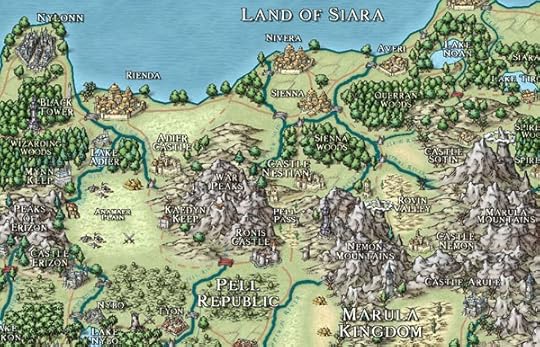
Figure 9: The Impact of Mountains
The Powers
On the left third of this map (and extending out of view) is Erizon, a seafaring nation like the federal republic of Siara, on the northern coast. They are philosophically opposed and have competing navies with unrestricted access to the northern sea and a continent to the north. With the border between them short, most clashes are on water.
The remaining sovereign power in the image is the southern Pell Republic, which I decided has recently become a federal republic (in contrast with most other neighbors) like Siara. They became allies partly because Erizon threatens both from the west, launching wars on Anamaer Plain, a region filled with nomadic horse tribes. Caught in the middle, some of those tribes are allied to different powers, depending on who can benefit them. The landscape suggested these relationships, which is one reason to draw maps.
Pell Pass is how those of Pell and Siara meet and trade, but in the mountains to either side are unpleasant species and animals that attack any caravan or sign of life. Before Pell and Siara became allies, they contested Pell Pass and guarded it with castles at either end, seen on the map. These are now where caravans prepare for the dangerous trip through. The War Peaks are named for the battles that have often raged on either side of them.
The Pell Republic doesn’t have the kinds of wood best for building ships and gets these materials from Siara, which has ships at Pell to access the Sea of Fire and lands beyond. This includes the Empire of Kysh, with whom Pell is on mostly good relations, partly because Kysh is also enemies with Erizon. Pell also has ships in Siara because it bought them from Siara.
The Kingdom of Marula to the southeast wants Pell’s territory, including Pell Pass, partly to stop Pell and Siara from conspiring against it. Marula is at the heart of the slave trade and prefers those of Pell and Siara for slaves, increasing animosities.
The post Case Study #3 in World Building appeared first on The Art of World Building.
April 19, 2018
Case Study #2 in World Building
This case study talks about how the location of one kingdom stopped an empire from expanding farther, with terrain and allegiances part of how this was invented.
The post Case Study #2 in World Building appeared first on The Art of World Building.
April 17, 2018
Case Study #1 in World Building
Whether we’re new to world building or a pro, the following case studies can give insight into how the material in this volume can help our efforts. They demonstrate what can result from learning the contents of this book: how land features and map making can lead to decisions on allies and enemies, trade routes, and what types of sovereign powers could exist. Concepts are alluded to here but not explained; world builders can revisit these case studies as knowledge of this book’s content is assimilated. The maps are also available online at http://www.llurien.com/continents/llorus/, where it might be easier to see what’s being referred to.
Each case study will use my setting, Llurien, because I know what I was thinking while creating it, as opposed to someone else’s world. It’s a fantasy world with knights, magic, gods, and seven species of my invention instead of the staples—elves, dwarves, and dragons.
Case Study 1—Two Straits and a Sea of Enemies
The first case is the effect two narrow straits have on access to a sea and how this affects the relationships of several sovereign powers. If following along with the maps online (instead of the one below), expand the following sovereign powers sections to see the maps: Erizon, Kysh, Marula, Niora, Pell, and Rone.
The Sea of Fire and Straits
On the western coast of this continent lies the Sea of Fire, which is accessible from the ocean to the west via two straits (two narrow channels) that flow north or south of the large island there (see the map below). The northern Strait of Erizon is not particularly treacherous due to its width. Technically, it’s too broad to be considered a strait; even on Earth we sometimes use the wrong word, so world builders can, too. The southern Strait of Niora is narrow enough to fit the definition of “strait” better due to being narrow, so I decided it is treacherous to differentiate it from the northern strait (variety is good).
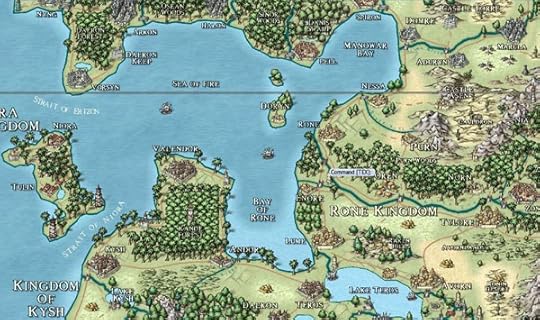
Figure 8: Controlling Territory
The Equator
The equator runs through the center of the sea, which means almost all the woods near the sea are rainforests. The equator’s location also means the prevailing winds are from the east (i.e., blowing east-to-west). When drawing a map, we should know where land lies in relation to the equator, as this impacts forest types, skin color of inhabitants, wind direction, and where rainfall occurs, which in turn affects vegetation or the lack thereof.
Erizon
Above the Strait of Erizon lies Erizon, a wizard-centric oligarchy, where personal liberties are fewer. It lies on the northwestern corner of the continent by the ocean, which suggests that Erizon is a seafaring power. Given its naval might and the proximity to the Strait of Erizon, it seems obvious that Erizon would want to control access to the Sea of Fire via the strait. This becomes the dominant factor in its relationships with every sovereign power to the east.

Figure 3: Erizon
Kysh
The Kingdom of Kysh is the heart of the Empire of Kysh. An empire requires stability, which suggested power not rest with a single person, so I decided the Kingdom of Kysh is a constitutional monarchy ruled by parliament. The king/emperor is a ceremonial head-of-state, not head of government. In other words, this is not an absolute monarchy where the leader is all powerful.
Kysh and Erizon have philosophically different forms of government, setting them up as potential ideological enemies, so I made this true. Erizon has resisted annexation by the Empire of Kysh partly because powerful wizards are in charge.
Kysh controls the difficult Strait of Niora just north of its capital. Since no one gets through there without Kysh’s cooperation, powers adjacent to the Sea of Fire might want to be on friendly terms with Kysh. Otherwise, to reach the ocean, their only option is the Strait of Erizon and Erizon’s ships. With Kysh respecting personal rights far more than Erizon, it is a potentially better ally. Both powers clash on the sea, whether in the Strait of Erizon or open ocean.
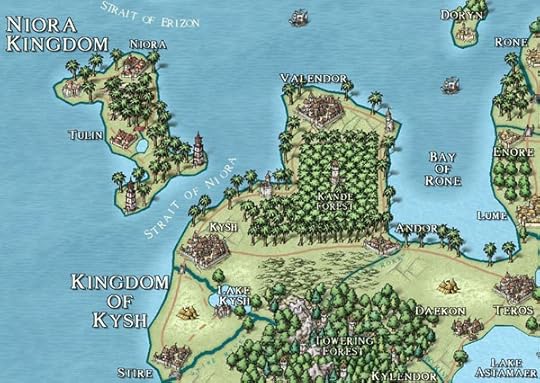
Figure 4: Kysh Kingdom
Niora
The island Kingdom of Niora separates the straits and influences both. The larger Erizon and Kysh have each conquered Niora more than once over the centuries. Both have left a lasting impact on culture and architecture. Niora seldom had time to develop a constitutional monarchy (i.e., a bigger government) that lasted very long. I therefore decided it’s an absolute monarchy, partly because it’s small enough for one extended family to remain in power when independent. It is currently part of the Empire of Kysh, giving the latter more control over the Strait of Erizon. This is another reason that a sovereign power inside the Sea of Fire might prefer an alliance with Kysh over Erizon.
Rone
That brings us to Rone Kingdom, which lies on the right of the Sea of Fire, across the Bay of Rone from Kysh. For reasons explained in “Case Study 2—Stopping an Empire’s Expansion,” Rone prevented the Kingdom/Empire of Kysh from expanding farther north and is therefore Kysh’s enemy. That leaves Erizon as Rone’s only ally regarding these straits, but what’s in it for Erizon? For one, enmity with Kysh implies friendship with Erizon, so Erizon will help Rone for a price, such as escort fees or high taxes on sold goods. Rone has also access to lands and resources to the east and south that Erizon doesn’t, causing some mutual benefits to an alliance. This tense partnership has fallen apart more than once. Finally, I made Rone a constitutional monarchy to distinguish it from Marula, its neighbor.
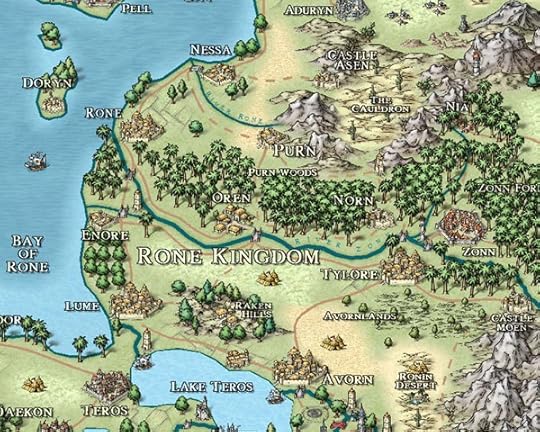
Figure 5: Rone Kingdom
Marula
To the northeast of Rone is the very hot Marula Kingdom, located at the equator and with some of the darkest skinned peoples (see the next map). The Marula Mountains to the east block the westerly prevailing winds, causing a rainforest on the eastern side of them and a rain shadow and desert on the western side where Marula stands. A desert normally can’t form near the equator due to heavy rains, but the tropical climate in Marula is really a temperate one due to high elevation, and this combination allows for a desert. Its people worship the sun and life-giving Alura River. Lacking many resources (like forests) and surrounded by enemies, it feels vulnerable, hence the ruling family’s insistence on holding onto power, resulting in a brutal, absolute monarchy. Marula has a small stretch of coastline and can be easily cut off from the sea and everything beyond, so it became Rone’s reluctant ally to gain aid on the sea and to prevent Kysh from conquering it next if Rone fell. The alliance is tense.
Marula and Erizon surround a common enemy (the Pell Republic) and are also philosophically compatible, making them allies. This gives Marula two allies on the Sea of Fire (Erizon and Rone) and two enemies (Pell and to a lesser extent, Kysh).
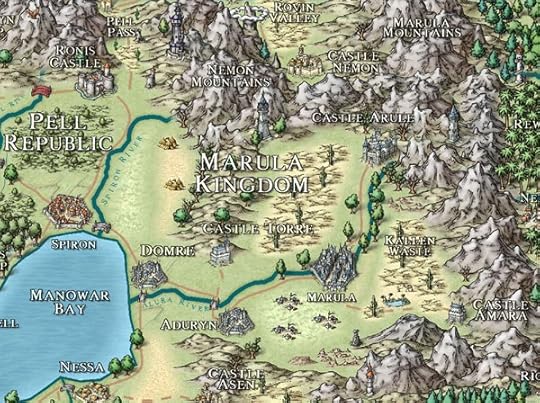
Figure 6: Marula Kingdom
Pell
Between Marula and Erizon stands Pell, a federal republic with great freedom for its citizens, putting it at philosophical odds with those neighbors (see next map). Pell became an ally of Kysh for protection and access to the ocean. Pell has another ally to the north, a larger federal republic called Siara, who has encouraged Pell’s transition from constitutional monarchy to republic. Siara and Erizon are enemies—they share a border—and Siara is another seafaring superpower with a small fleet stationed at Pell, its ally. Erizon tries to thwart Siara from sailing around it and entering the Sea of Fire, so Siara responds, in part, by just building ships at Pell. See “Case Study 3—Mountains and Murder,” for more about this relationship and how geography suggested it.
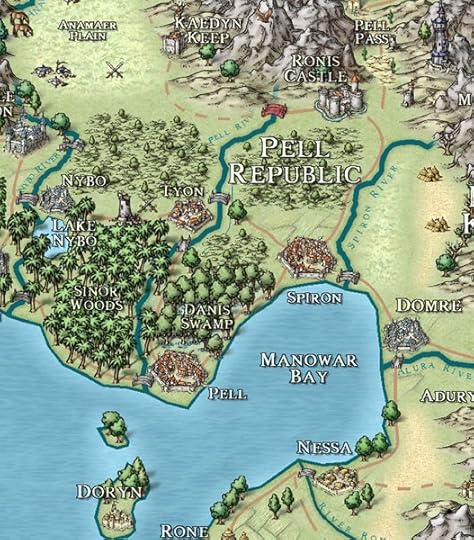
Figure 7: The Pell Republic
Naming Considerations
The sea’s location at the equator and the often-heard command to “fire” during the frequent ship battles on its waters suggested a name: the Sea of Fire. Manowar Bay also received its name from the ships-of-the-line that sometimes blockade access to the sea.
The post Case Study #1 in World Building appeared first on The Art of World Building.
April 13, 2018
Introduction Conclusion (Vol. 2)
Effective world building requires having written down details about the created world. To help you organize and jumpstart your efforts, each volume in this series includes templates in the appendices. This volume includes three: solar systems, sovereign powers and settlements.
Rather than typing these up yourself, you can download these templates for free by joining the newsletter for The Art of World Building at http://www.artofworldbuilding.com/newsletter. As each volume is published, whether you’ve bought the book or not, subscribers will automatically receive an email with links to download the templates as Microsoft Word files.
In addition, this volume provides two Microsoft Excel files for calculating moon orbits and travel times on land, sea, and air. While the formulas are discussed in the book, the files come set with the needed calculations. I recommend that interested world builders download them rather than try to create them.
The Podcast
The Art of World Building podcast expands on the material within the series. The additional examples offer world builders more insight into ramifications of decisions. You can hear the podcast, read transcripts, and learn more about the episodes at http://www.artofworldbuilding.com/podcasts.
Images
This book includes a number of images, which are greyscale in the print copy and color in the eBook. Larger, full color copies can be viewed for free online at http://www.artofworldbuilding.com/creatingplaces/images. They are organized by chapter and will provide more detail that make it easier to learn from.
Creating Life (Volume One)
The places we create are of little interest without life forms to dwell there, whether these are gods, species and races, plants, animals, monsters, and even undead. Creating Life (The Art of World Building, #1) goes into detail about inventing such people and making them memorable so our work stands out in a crowded field. The skilled use of analogues and how much world building to do are also discussed. We can start our work with any one of those subjects and crisscross between places and life, for one often impacts the other.
Cultures and Beyond (Volume Three)
Everything not covered in the first two volumes lies within the finale, Cultures and Beyond (The Art of World Building, #3). This includes creating culture, language, religions, military groups, the supernatural, technology, magic items, names, and even mundane items like a monetary system. Much of this work ties together our life forms and places. These are the things we comment on most during a story and which our characters consider. Without them, no world building project is complete.
The post Introduction Conclusion (Vol. 2) appeared first on The Art of World Building.
April 9, 2018
Chapter Summaries (Vol. 2)
What follows is a summary of what’s included in each chapter in volume two, Creating Places.
Chapter 1—Case Studies
Three case studies show how the contents of this volume can aid in creating relationships we can use in our work. They discuss the effects of prevailing winds, climate, land features, rain shadows, and the impact of passages to travel through troubling areas. Each affects the sort of sovereign power suggested by a region and how alliances and enemies can be forged, some changing with time. Each power will have different ideologies and geographical features and needs, which can help us determine relationships between different powers.
Chapter 2—Creating a Planet
This chapter focuses on creating an Earth-like planet. World builders should understand the role of the moon and its effects on tides, seasons, and more if we intend to have a moon different from our own or multiple moons. Mention of other planets, constellations, and comets can make our world seem like it’s not an island. The equator, climate zones, prevailing winds, and rain shadows all affect how much precipitation falls in an area, which in turn affects all life there, including vegetation or the lack thereof. Understanding these basics will help us create believable landscapes.
Chapter 3—Creating a Continent
Which hemisphere our continent lies in affects the seasons and might impact where we place constellations. Understanding plate tectonics can help us build believable mountain ranges and place volcanoes where they might occur. This can also determine where deep areas of the sea are, giving our sea monsters somewhere to call home. We have some liberty to name bodies of water what we want, but this chapter includes details on when to use which name, including seas, bays, inlets, and more.
Chapter 4—Creating Land Features
A continent will have mountains, volcanoes, lakes, rivers, forests, woodlands, savannahs, jungles, prairies, wetlands, and deserts, but world builders should understand each to place them in believable locations. While some aspects are obvious, minor details can change our decisions and augment our resulting stories. Why say characters have entered a run-of-the-mill forest when we can say it’s a savannah instead, describing how it looks and what life is like for inhabitants and those traversing it? This chapter aids world builders in making a more varied landscape—one that is accurately depicted.
Chapter 5—Creating a Sovereign Power
Kingdoms, empires, dictatorships and more are types of sovereign powers that world builders can create. Before we do, a high-level understanding of the differences between them is crucial. Many variations to government types exist, which gives us freedom to tweak details for our needs, but we should know the rules before we break them. The role of sovereignty, including how it is gained and lost, is examined in this chapter along with the “divine right of kings.” We also look at the head of state and head of government roles, the differences between them, and the conflicts that can arise. The nature of each branch of government is examined along with parliamentary systems. Democracies, federations, theocracies, monarchies, autocracies and more are examined for their key differences.
Inventing a sovereign power should include friends and enemies who shape policy, lifestyle, and culture. The form of government has significant impact on inhabitants and results from world view. History affects this as well, and while creating a history is optional, it enriches the dynamics of relationships and can create heroes, villains, and attitudes in the population. We should consider which species are present and in how great a percentage, and what languages are spoken or forbidden. Our power’s location and climate will impact lifestyles and vegetation, which also influences what natural resources it has or lacks, and what the power does as a result. These can all lead to tensions both with other powers or the residents. Symbols, colors, flags, and slogans will be a source of pride and even fear for both foreigners and the population.
Chapter 6—Creating a Settlement
Location impacts a settlement more than many world builders realize, from climate to terrain and water supply, but our neighbors also determine how much fortification is needed and the number of armed forces, including their skill sets. Ancient and recent history can bring lasting change and cause attitudes that enrich our setting. Our population’s diversity is also critical for determining what life is like for the majority and minorities alike, but first we need to decide who is who (and why), how much power they have, and whether they can subvert those who are supposedly in power. Whether outposts, castles, villages, towns, or cities, or even an orbiting station, a settlement will have secrets, a reputation, colors, symbols, and local lore that characterize it in the minds of inhabitants, friends and enemies.
Chapter 7—Travel Over Land
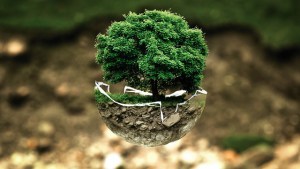 In settings without automobiles, world builders may struggle to determine how long it really takes people to traverse a distance, whether that’s between settlements or land features. Mountains, hills, desert, and vegetation all impact speed and endurance, whether one is walking, riding a steed (even flying on one), or hauling freight like a wagon. The presence and quality of roads alter this, as do life forms that might cause wariness and therefore slower travel. A methodology is presented to assist with organizing distance measurements and scale, determining the base miles per day (BMPD) for various mode of travel, and terrain modifiers to BMPD. Using both miles and kilometers, formulas are provided for making calculations, which can also be estimated for overall land area in sovereign powers. Newsletter subscribers receive an Excel spreadsheet that can be used to alter scale and modifiers so that all calculations are automatically updated, reducing the need for manual calculations.
In settings without automobiles, world builders may struggle to determine how long it really takes people to traverse a distance, whether that’s between settlements or land features. Mountains, hills, desert, and vegetation all impact speed and endurance, whether one is walking, riding a steed (even flying on one), or hauling freight like a wagon. The presence and quality of roads alter this, as do life forms that might cause wariness and therefore slower travel. A methodology is presented to assist with organizing distance measurements and scale, determining the base miles per day (BMPD) for various mode of travel, and terrain modifiers to BMPD. Using both miles and kilometers, formulas are provided for making calculations, which can also be estimated for overall land area in sovereign powers. Newsletter subscribers receive an Excel spreadsheet that can be used to alter scale and modifiers so that all calculations are automatically updated, reducing the need for manual calculations.
Chapter 8—Travel by Water
Landlubbers have difficulty determining how long it takes for any ship, whether powered by oars or sails, to traverse a distance. This chapter explores the factors affecting sailing speeds and what vessels are most likely to be used during an Age of Sail period. Calculations are provided for realistic estimates. Both long and round ships are discussed, including the galley, brig, frigate, galleon, sloop-of-war, and ship-of-the-line. In fantasy, we have species and warrior types who might be part of our crew. We might also rule out gunpowder and cannon, which means having ships with no real fire power or which use alternative weapons, some of which are examined. Subscribers to The Art of World Building newsletter receive an Excel spreadsheet that performs calculations in kilometers, miles, and nautical miles.
Chapter 9—Travel in Space
Science fiction features invented technologies for traveling the cosmos, but that doesn’t free us from attempts to be realistic about life in space or how to maneuver. Modern engines operate on the principle of thrust, which requires rear-facing engines, and we’ll need this for slower-than-light travel within a solar system. Imaginary propulsions, like warp, hyper, or jump drives can benefit from believable limitations. We should also remember that locations in space are ever changing positions so that how long it takes to travel between two points is seldom the same—or convenient for our characters. The need to enter a planet’s atmosphere affects the structure of our ship, but world builders will be most interested in the internal organization and the effect we can make this have on people and story.
Chapter 10—Creating Time and History
History can enrich a world and provide us with cultural clashes, famous items, and world figures to which our stories and characters can refer or cite as inspiration. To save time, we can create a master history file with short entries that are invented in a few minutes and which do not need long explanations. Some could be turned into stand-alone stories if we stumble upon a great idea. Historic entries can be created at any time and can include events involving the gods, technology, supernatural, wars, the rise and fall of sovereign powers, artifacts, and famous missions by groups or individuals.
We also need a universal way to measure time because each sovereign power might have its own calendar, making the correlation of events across kingdoms harder. The merits of keeping timeframes similar to Earth’s are discussed; this includes the reasons why minutes and hours benefit from little alteration, while the number of days, weeks, and months can experience greater variation without disrupting the audience’s sense of time.
Chapter 11—Creating Places of Interest
Even seemingly ordinary locations can acquire significance due to scale, features, or people associated with them. These include monuments, graves, catacombs and hidden passages, and unusual buildings, whether built in stone, flying in the air, or floating on water like Venice. Ruins offer places for treasure to be found or horrors unleashed, including magical or technological items. Event sites and shipwrecks also give inhabitants places to reference, seek, or avoid, and can be where items of our invention originated.
Bonus Chapter 12—Drawing Maps
While drawing maps is optional in world building, they can help us visualize where everything’s taking place, and if done well, can even be included in published works. Drawing skill isn’t really needed, as modern map making programs allow us to place pre-existing shapes onto a map and move them around. Continent maps help us decide on the location and quality of land features like mountains, forests, and deserts so that we create a realistic ecosystem. The location of settlements, rivers, and bodies of water will also impact the stories and lives of characters we create. We can also draw settlement, dungeon, and ship maps to solidify our decisions and find new inspiration in our layouts.
The post Chapter Summaries (Vol. 2) appeared first on The Art of World Building.
April 5, 2018
About Me and Disclaimers (Vol. 2)
By profession I’m a software developer, but I’ve been writing fantasy fiction since 1988 and building worlds just as long, mostly one planet called Llurien. Yes, I am crazy. But I love what I do. I didn’t intend to work on it for so long, but when life has prevented me from writing, I’ve worked on Llurien. I’ve done everything in these chapters and authored two hundred thousand words of world building in my files. Llurien even has its own website now at http://www.llurien.com. I’ve written six novels and over a dozen short stories over the years, and have just begun my publishing career with a novella that you can read for free (see below).
I’m also a musician with a degree in classical guitar; I’ve released three albums of instrumental rock, one classical guitar CD, and a disc of acoustic guitar instrumentals. You can learn more, hear songs, and see videos at my main website, http://www.randyellefson.com.
Free Book
If you’d like to see a free sample of my own world building efforts in action, anyone who joins my fiction newsletter receives a free eBook of The Ever Fiend (Talon Stormbringer). Please note there’s also a newsletter for The Art of World Building that is separate, though both can be joined on the same signup form. Just check the box for each at http://www.randyellefson.com/newsletter.
Disclaimers
World building is defined as the act of creating an imaginary world. While that suggests an entire planet, the result is often one continent or less. By world building, I don’t mean using pre-existing ideas and putting your own spin on them, such as reimagining Greek gods in modern or ancient times, or writing an alternate reality of Earth. While such approaches are fine, that’s not what this series is about, though such creators may still find the series useful.
I’ve omitted the science behind any real or imagined technology (like the warp drive from Star Trek) because other books on these subjects exist. Something like plate tectonics is discussed in this volume because it impacts the formation of mountains, but the details of subduction zones are seldom relevant for us when drawing mountain ranges, for example.
While some authors prefer the term “races” to “species,” I’ve used the latter term throughout most of the series. This book uses “SF” to abbreviate science fiction. SF is broadly defined herein as a setting with technology far in excess of current capabilities. Fantasy is loosely defined in this book as a setting using magic, knights, and lacking modern technology. As a stylistic point, to avoid writing “he/she,” I’ve also opted for “he” when discussing someone who could be either gender.
Since I am an author, and primarily write fantasy, the series is admittedly weighted in this direction, but whether you’re in the gaming industry, a screenwriter, a hobbyist, or write science fiction, much of the three volumes can help you anyway. I just don’t claim to have covered every element despite my attempts to be reasonably comprehensive. If you have suggested topics you feel should be covered, feel free to contact me at mail@randyellefson.com about updates for later editions.
The post About Me and Disclaimers (Vol. 2) appeared first on The Art of World Building.
April 2, 2018
Creating Places: Introduction
Note: this is the start of Creating Places (The Art of World Building, #2).
Introduction
If we’ve created gods, species, plants, animals, monsters, and more such as in Creating Life (The Art of World Building, #1), we need somewhere for everyone to live. Creating the world itself can help us envision conflicts, alliances, and struggles our characters might endure while traveling across mountains, through forests, or over the sea.
In this volume, we’ll discuss:
Solar systems, planets, moons, stars, constellations, and more
Continents, oceans, seas, and other water bodies
Land features such as forests, mountains, and deserts
Sovereign powers like kingdoms
Settlements such as cities, towns, villages, and more
Travel on land, sea, and in space by various means of locomotion (horse, wagon, dragons, ships) and how to consistently calculate travel times
Places of interest
History
Drawing maps for continents, settlements, and more
The examples included in the text were created specifically for this guide and are not drawn from any setting I’ve created, except in rare instances and in Chapter One, “Case Studies” (drawing new maps for that is too time consuming).
The series has a website at http://www.artofworldbuilding.com, where you can find additional resources, information on other volumes in this series, and other items as they are added.
Where to Start
The series and chapters within each volume can be read in any order but are arranged according to what might come first in a world’s timeline. A planet precedes continents, which precede land features, et al. But our creations can be invented in any order. Only you can decide where to begin, but it’s recommended to take any idea and run with it, writing down whatever occurs to you. If there are problems with it, they can be fixed later as you update and improve upon it. If you haven’t read a chapter in this book and have an idea for something that’s covered here, you can adjust your work later.
So where do you start? Where your heart lies.
The post Creating Places: Introduction appeared first on The Art of World Building.
March 29, 2018
Creating Life Conclusion
I’ve often joked that I find it hard to believe that God created the world in only six days because it takes me forever. Hopefully this volume will speed you along in your own invention of life. It bears repeating that world building is optional and not everything in this series must be done. Try to avoid feeling overwhelmed. If this happens, take a break. You might be taking everything too seriously. As your world’s ultimate god, what you say goes. This includes a decision to skip over the invention of something because you don’t need it, don’t care, don’t have the time, or don’t have an idea. This book and the templates should help you flesh out forgotten areas of invention, but it’s okay to have blanks in your files where nothing is written about a subject; I have left things this way for over a decade. One day it will occur to you (or not) to write something for that subject, especially when you need it for your project.
Don’t let this become a chore. World building is fun.
The post Creating Life Conclusion appeared first on The Art of World Building.
March 26, 2018
Can Your Undead Die?
Learn how to decide whether your undead can die or not, under what circumstances, and what happens to their remains.
The post Can Your Undead Die? appeared first on The Art of World Building.


